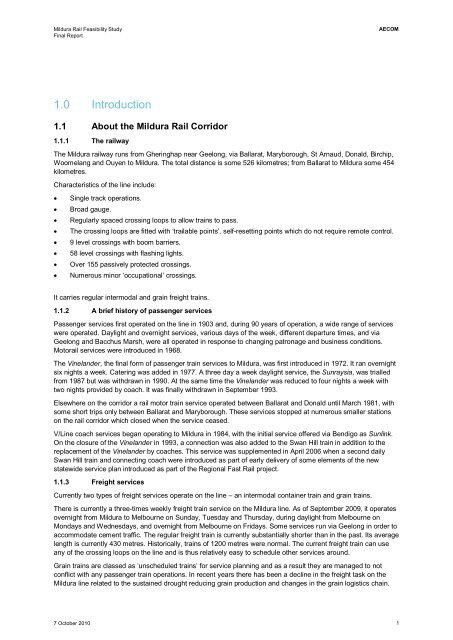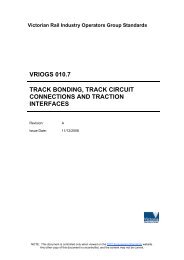Mildura Rail Feasibility Study - Public Transport Victoria
Mildura Rail Feasibility Study - Public Transport Victoria
Mildura Rail Feasibility Study - Public Transport Victoria
You also want an ePaper? Increase the reach of your titles
YUMPU automatically turns print PDFs into web optimized ePapers that Google loves.
<strong>Mildura</strong> <strong>Rail</strong> <strong>Feasibility</strong> <strong>Study</strong><br />
Final Report<br />
AECOM<br />
1.0 Introduction<br />
1.1 About the <strong>Mildura</strong> <strong>Rail</strong> Corridor<br />
1.1.1 The railway<br />
The <strong>Mildura</strong> railway runs from Gheringhap near Geelong, via Ballarat, Maryborough, St Arnaud, Donald, Birchip,<br />
Woomelang and Ouyen to <strong>Mildura</strong>. The total distance is some 526 kilometres; from Ballarat to <strong>Mildura</strong> some 454<br />
kilometres.<br />
Characteristics of the line include:<br />
<br />
<br />
<br />
<br />
<br />
<br />
<br />
<br />
Single track operations.<br />
Broad gauge.<br />
Regularly spaced crossing loops to allow trains to pass.<br />
The crossing loops are fitted with ‘trailable points’, self-resetting points which do not require remote control.<br />
9 level crossings with boom barriers.<br />
58 level crossings with flashing lights.<br />
Over 155 passively protected crossings.<br />
Numerous minor ‘occupational’ crossings.<br />
It carries regular intermodal and grain freight trains.<br />
1.1.2 A brief history of passenger services<br />
Passenger services first operated on the line in 1903 and, during 90 years of operation, a wide range of services<br />
were operated. Daylight and overnight services, various days of the week, different departure times, and via<br />
Geelong and Bacchus Marsh, were all operated in response to changing patronage and business conditions.<br />
Motorail services were introduced in 1968.<br />
The Vinelander, the final form of passenger train services to <strong>Mildura</strong>, was first introduced in 1972. It ran overnight<br />
six nights a week. Catering was added in 1977. A three day a week daylight service, the Sunraysia, was trialled<br />
from 1987 but was withdrawn in 1990. At the same time the Vinelander was reduced to four nights a week with<br />
two nights provided by coach. It was finally withdrawn in September 1993.<br />
Elsewhere on the corridor a rail motor train service operated between Ballarat and Donald until March 1981, with<br />
some short trips only between Ballarat and Maryborough. These services stopped at numerous smaller stations<br />
on the rail corridor which closed when the service ceased.<br />
V/Line coach services began operating to <strong>Mildura</strong> in 1984, with the initial service offered via Bendigo as Sunlink.<br />
On the closure of the Vinelander in 1993, a connection was also added to the Swan Hill train in addition to the<br />
replacement of the Vinelander by coaches. This service was supplemented in April 2006 when a second daily<br />
Swan Hill train and connecting coach were introduced as part of early delivery of some elements of the new<br />
statewide service plan introduced as part of the Regional Fast <strong>Rail</strong> project.<br />
1.1.3 Freight services<br />
Currently two types of freight services operate on the line – an intermodal container train and grain trains.<br />
There is currently a three-times weekly freight train service on the <strong>Mildura</strong> line. As of September 2009, it operates<br />
overnight from <strong>Mildura</strong> to Melbourne on Sunday, Tuesday and Thursday, during daylight from Melbourne on<br />
Mondays and Wednesdays, and overnight from Melbourne on Fridays. Some services run via Geelong in order to<br />
accommodate cement traffic. The regular freight train is currently substantially shorter than in the past. Its average<br />
length is currently 430 metres. Historically, trains of 1200 metres were normal. The current freight train can use<br />
any of the crossing loops on the line and is thus relatively easy to schedule other services around.<br />
Grain trains are classed as ‘unscheduled trains’ for service planning and as a result they are managed to not<br />
conflict with any passenger train operations. In recent years there has been a decline in the freight task on the<br />
<strong>Mildura</strong> line related to the sustained drought reducing grain production and changes in the grain logistics chain.<br />
7 October 2010 1

















